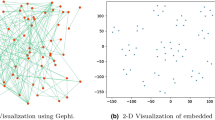
Overview
- Highlights the understanding of complex systems in different domains including health, education, agriculture, and transportation
- Combines both conventional machine learning (ML) and deep learning (DL) techniques to understand complex systems
- Presents neural networks and Deep Learning (DL) techniques useful in network embedding
Part of the book series: SpringerBriefs in Applied Sciences and Technology (BRIEFSAPPLSCIENCES)
Part of the book sub series: SpringerBriefs in Computational Intelligence (BRIEFSINTELL)
Buy print copy
About this book
This book deals with network representation learning. It deals with embedding nodes, edges, subgraphs and graphs. There is a growing interest in understanding complex systems in different domains including health, education, agriculture and transportation. Such complex systems are analyzed by modeling, using networks that are aptly called complex networks. Networks are becoming ubiquitous as they can represent many real-world relational data, for instance, information networks, molecular structures, telecommunication networks and protein–protein interaction networks. Analysis of these networks provides advantages in many fields such as recommendation (recommending friends in a social network), biological field (deducing connections between proteins for treating new diseases) and community detection (grouping users of a social network according to their interests) by leveraging the latent information of networks. An active and important area ofcurrent interest is to come out with algorithms that learn features by embedding nodes or (sub)graphs into a vector space. These tasks come under the broad umbrella of representation learning. A representation learning model learns a mapping function that transforms the graphs' structure information to a low-/high-dimension vector space maintaining all the relevant properties.
Similar content being viewed by others
Keywords
Table of contents (6 chapters)
-
Front Matter
-
Back Matter
Authors and Affiliations
About the authors
M.N. Murty is currently a Professor in the Department of Computer Science and Automation at the Indian Institute of Science, Bangalore. His research interests are in the area of pattern recognition, data mining, and social network analysis.
Ms. Manasvi Aggarwal is currently pursuing her M.S. at the Indian Institute of Science, Bangalore. Her research interest is in the areas of social networks and machine learning
Bibliographic Information
Book Title: Machine Learning in Social Networks
Book Subtitle: Embedding Nodes, Edges, Communities, and Graphs
Authors: Manasvi Aggarwal, M.N. Murty
Series Title: SpringerBriefs in Applied Sciences and Technology
DOI: https://doi.org/10.1007/978-981-33-4022-0
Publisher: Springer Singapore
eBook Packages: Computer Science, Computer Science (R0)
Copyright Information: The Author(s), under exclusive license to Springer Nature Singapore Pte Ltd. 2021
Softcover ISBN: 978-981-33-4021-3Published: 26 November 2020
eBook ISBN: 978-981-33-4022-0Published: 25 November 2020
Series ISSN: 2191-530X
Series E-ISSN: 2191-5318
Edition Number: 1
Number of Pages: XI, 112
Number of Illustrations: 11 b/w illustrations, 18 illustrations in colour
Topics: Computational Intelligence, Machine Learning, Artificial Intelligence, Mathematical Models of Cognitive Processes and Neural Networks



